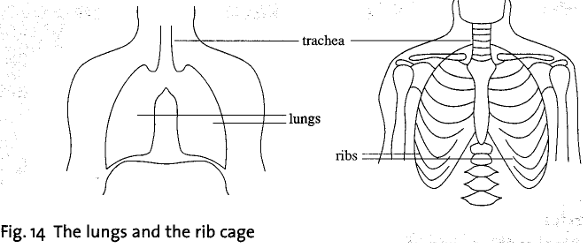
Respiration and voicing
 المؤلف:
Peter Roach
المؤلف:
Peter Roach
 المصدر:
English Phonetics and Phonology A practical course
المصدر:
English Phonetics and Phonology A practical course
 الجزء والصفحة:
35-4
الجزء والصفحة:
35-4
 2024-10-12
2024-10-12
 1467
1467
Respiration and voicing
We referred several times to air passing between the vocal folds. The normal way for this airflow to be produced is for some of the air in the lungs to be pushed out; when air is made to move out of the lungs we say that there is an egressive pulmonic airstream. All speech sounds are made with some movement of air, and the egressive pulmonic is by far the most commonly found air movement in the languages of the world. There are other ways of making air move in the vocal tract, but they are not usually relevant in the study of English pronunciation, so we will not discuss them here.
How is air moved into and out of the lungs? Knowing about this is important, since it will make it easier to understand many aspects of speech, particularly the nature of stress and intonation. The lungs are like sponges that can fill with air, and they are contained within the rib cage (Fig. 14).

If the rib cage is lifted upwards and outwards there is more space in the chest for the lungs and they expand, with the result that they take in more air. If we allow the rib cage to return to its rest position quite slowly, some of the air is expelled and can be used for producing speech sounds. If we wish to make the egressive pulmonic airstream continue without breathing in again - for example, when saying a long sentence and not wanting to be interrupted - we can make the rib cage press down on the lungs so that more air is expelled.
In talking about making air flow into and out of the lungs, the process has been described as though the air were free to pass with no obstruction. But, to make speech sounds we must obstruct the airflow in some way - breathing by itself makes very little sound. We obstruct the airflow by making one or more obstructions or strictures in the vocal tract, and one place where we can make a stricture is in the larynx, by bringing the vocal folds close to each other. Remember that there will be no vocal fold vibration unless the vocal folds are in the correct position and the air below the vocal folds is under enough pressure to be forced through the glottis.
If the vocal folds vibrate we will hear the sound that we call voicing or phonation. There are many different sorts of voicing that we can produce - think of the differences in the quality of your voice between singing, shouting and speaking quietly, or think of the different voices you might use reading a story to young children in which you have to read out what is said by characters such as giants, fairies, mice or ducks; many of the differences are made with the larynx. We can make changes in the vocal folds themselves - they can, for example, be made longer or shorter, more tense or more relaxed or be more or less strongly pressed together. The pressure of the air below the vocal folds (the subglottal pressure) can also be varied. Three main differences are found:
• Variations in intensity: We produce voicing with high intensity for shouting, for example, and with low intensity for speaking quietly.
• Variations in frequency: If the vocal folds vibrate rapidly, the voicing is at high frequency; if there are fewer vibrations per second, the frequency is lower.
• Variations in quality: We can produce different-sounding voice qualities, such as those we might call harsh, breathy, murmured or creaky.
 الاكثر قراءة في Phonetics and Phonology
الاكثر قراءة في Phonetics and Phonology
 اخر الاخبار
اخر الاخبار
اخبار العتبة العباسية المقدسة


